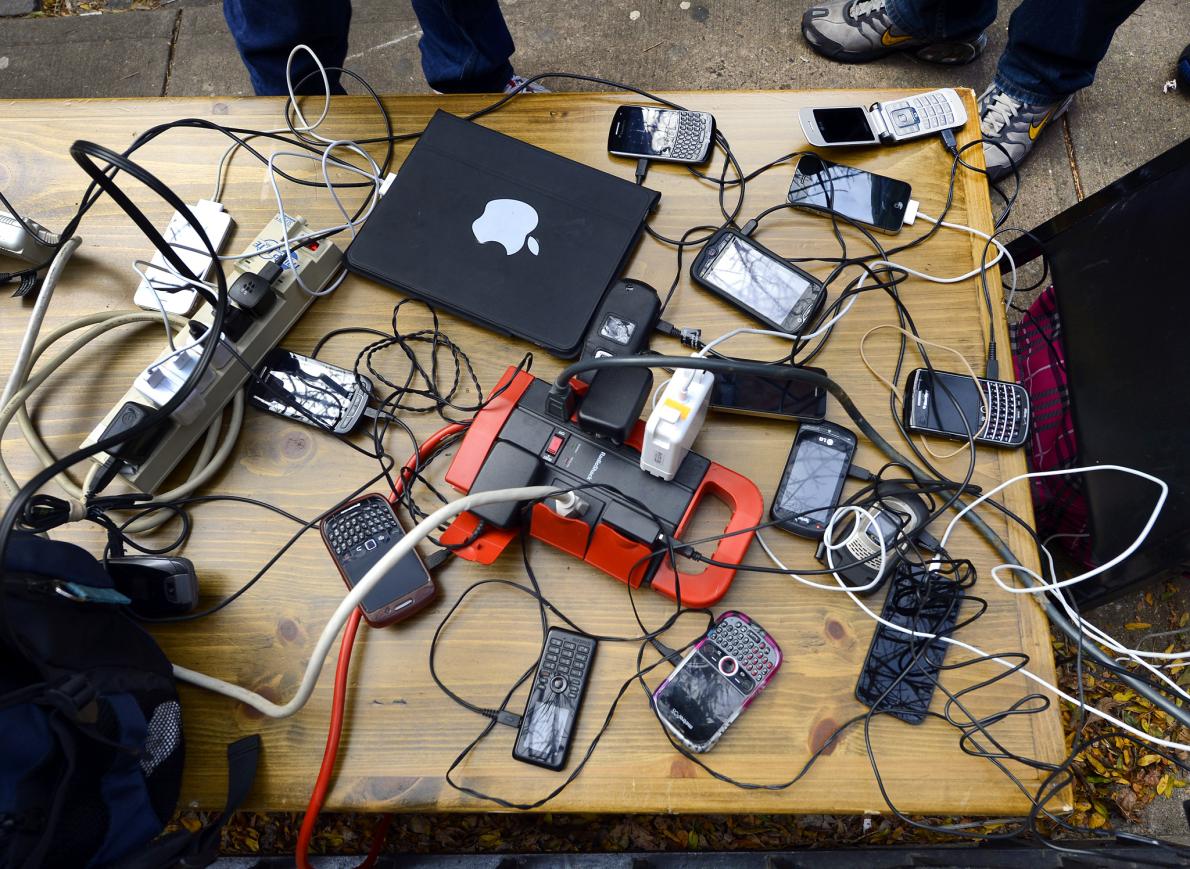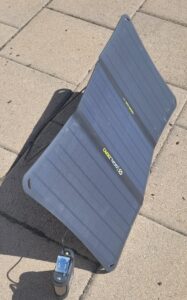I try to standardize on batteries for obvious reasons. Broadly, I lead a life of AA- and D-batteries. But as of late, it seems like more and more devices use rechargeable batts that are recharged through a USB connection of some kind. I’m kinda liking this from a survivalist stanpoint.
There are plenty of chargers out there to recharge AA and D batts from various sources, I recognize that. But it’s just so much easier to order up a small folding solar panel, plug in your USB cable, and start charging your device. The things that, most notably, come to mind are cellphones (which have tremendous utility even in a world without phone signal), flashlights, small radios, and that sort of thing.
I’ve also a few devices that can use either available batteries or use built-in rechargeable-through-USB. For example, the Fenix PD35 that I picked up a while back will run off a couple CR123 batts or can be run off its rechargeable battery. Thats pretty handy.
I had a small folding Goal 0 panel that, while handy, has a rather small footprint, and when it comes to solar charging the more panel area you have the better. There is, of course, a point of diminishing return…you want a panel thats large enough to get the job done but, at the same time, you want a level of portability and compactness to make transport and storage a bit easier. Seems like a reasonable idea, yes?
Goal Zero sometimes has ‘road shows’ at CostCo and they have some very interesting stuff. I have a bunch of their daisy-chainable LED 12v loights that I highly recommend. I decided I wanted to get a little package that wouuld charge AA (and AAA) batteries, charge a phone battery pack, and could charge other USB-connectable devices. By charging AA batts that gives me a lot more use to handheld GPS, AA flashlights, radios, weaponlights, weapon sights (for the ones that run on AA or AAA), my ICOM R6, and a host of other AA-batt compatible devices.
So, off to Amazon for:
- Goal Zero 21005 Guide 10 Plus 11Wh/2300mAh Power Bank, AA & AAA Battery Recharger, Solar Ready
- Goal Zero Venture 35 Portable Charger Power Bank 9600mAH 18W USB-C Power Delivery Port 2 USB Outputs IP67 Rating 50 Lumens Flashlight
- Goal Zero Nomad 20, Foldable Monocrystalline 20 Watt Solar Panel with 8mm + USB Port, Portable Solar Panel Charger. Lightweight 18-22V 20W Solar Panel Charger with Adjustable Kickstand

Hurricane Sandy left some folks with power, and they became very popular very quickly. I’m trying to avoid this sort of social clusterbomb.
A couple things to note… The Guide 10 battery charger has a USB port to allow you to use it to charge your USB devices. So far so good. However, it is 5v 1amp vs 5v 3amp of the Venture power bank. What this means is that while the battery charger, with a load of recharged batteries in it, will charge your phone or device…its gonna take a while.
The Venture is 5v 3amp so its gonna charge your toys a good bit faster.
Both devices can be charged from other sources, such as a wall outlet using a USB cord and plug-in. Both devices also incorporate a basic power level indicator and also have an LED flashlight feature. Handy, but shouldnt you already have a flashlight?
I drained all the batteries in the Guide to 0% and did the same with the Venture. I set up the panel in the sun, tucked the Venture or Guide behind the panel in the shade to keep it from cooking, and left it while I went to work. When I got back in the afternoon, the devices indicated a full charge. (Note: they were not charged at the same time. The panel has one USB port, so I alternated.)
 The panels themselves seem fairly durable. I’d try to avoid bending or flexing them (although there are flexible panels out there). In terms of compactness, the panels, when folded up, are about an inch or so thick, and takes up a footprint slightly smaller than a sheet of paper.
The panels themselves seem fairly durable. I’d try to avoid bending or flexing them (although there are flexible panels out there). In terms of compactness, the panels, when folded up, are about an inch or so thick, and takes up a footprint slightly smaller than a sheet of paper.
You can, of course, plug whatever device you are trying to recharge directly into the panel’s USB port but then your device is subject to the vagaries of uneven charging as the sun may or may not experience some transitory cloud cover. (And, wow, my brain parses ‘vagaries’ completely different than what it means when it see it on screen. Gotta check that word twice.)
Really, the best option, it seems to me, is to use the panel to charge your storage device..batteries or power bank….and then charge your device from those. And, of course, you can charge your other devices from that power bank as well.
So..I’ll play with this stuff and see how it goes but so far it seems like an acceptable way to keep my small devices topped off when grid power just isnt in the cards.

USB charging, but a point to make. USB cables vary, and all of them are consumables. REALLY consumable when children are involved.
Best case scenario, plug the thing in to charge, se it down, and leave it alone till charged. Like every wire known to man, vibration and movement cut the life of the wire. A teenager charging their phone can destroy a cable in a few weeks flat simply because they won’t put down the phone.
I order USB cables by the 4-pack, and keep a pack in reserve.
Thank you! Nobody told me about the fragility of wires – I thought I was just being too hard on them. And I’m more than a few decades past my teens!
Keep in mind that most of the USB cables today use aluminum wires. They will break with minimal flexing. Spend the money for the good ones. It’ll pay in the long run.
I have 3 different Goal Zero panels, and each member of the family has a GZ Flip 24 charging block. All have worked very well over the last 3-5 years without a hiccup. Never tried the batteries, but our family is using Pale Blue batteries instead of disposables. They work great, and can be recharged thousands of times. They have sizes AAA through D, along with 9V. They charge via USB-C on the battery itself. Can also be charged by the GZ panels and blocks.
I’d agree about built-in rechargeables, but withhold full approval until I see real-world data on life cycle resiliency, and EMP hardiness.
I’m so suspicious about the whole constant EMP threat these days. Sometimes it’s “END OF THE WORLD” but if you put it inside of this metal trash can – you’ll be saved! They’re using data from the 40’s/50’s claiming it applies to today’s technology that has built in resistors, shielding that far surpasses what was used back then. We constantly drive through magnetic fields that could effect equipment but doesn’t. The technology available to survivalists/preppers today is amazing to 10-20 years ago with solar and batteries. The LED lanterns/flashlights alone have been amazing vs using the traditional Deitz hurricane lanterns or the top of the line Aladdins or Mag-lites. Switching to the USB devices has also been a challenge since there’s so many things out there now, including the different solar panels. I’ve been looking into getting one of the larger power banks from EcoFlow or Buetti to use in conjunction with the generator to help run things mainly at night so the drone of a generator isn’t permeating the neighborhood or to be more stealthy. Jackery and GoalZero need to upgrade to the newer batteries that have far many more cycles and safer to use in the elements. In the past, I’ve modded a couple of the old battery jump boxes to do both 12v cigarette socket and dual USB sockets and new 20a/hr batteries.
It’s a great point about getting multiple USB cables. I’ve been switching to magnetic ports for my devices and it saves the ports from the constant in and out of the cables.
The trouble with your take on the effects of an EMP is that you don’t account for the delicate nature of today’s electronics. What used to take hundreds of watts to operate now take a few milliwatts to run, and the components are sized accordingly. Even the EMP generated by a nearby lightning strike or a power surge on the line is enough to take out just about everything in your house with a motherboard in it. ..And that’s A LOT of stuff!!! Even your stove, dishwasher, refrigerator, and washing machine have motherboards now. Believe me; this stuff is NOT shielded! In fact, most of it has a statement required by the FCC (in the US) that says the device is required to accept any and all interference, including that which may cause unintended operation. That is NOT shielded! Even devices that ARE shielded have critical flaws when it comes to an EMP. If it has wires going through the shielding, such as those going into the otherwise well-shielded computers in cars, THOSE are your Trojan horses.
…That being said, whether your stuff will survive an EMP will be a crapshoot. How strong was the EMP? How far away was it? What were the frequencies generated? Was your stuff in a safe or metal cabinet? Was your car out in the open or in a parking garage?
…Like they say, “Pray for peace. Prepare for war…”
Thanks for the reply. Good points to think about especially with lightening strikes. That alone is a reason to keep some things roughly shielded so it’s not a total loss. I still keep some stuff in the magical lined trash can – couple of inverters, older laptop and HT radios, spare charge controller, couple small battery banks and will be adding a 75w flexible solar panel and various cables to it – just in case.
All your eggs. One basket. Discuss.
Marry technology in haste. Repent at leisure.
I’ve tested my backpacking solar panel and agree emphatically that charging a power bank works much better than plugging a phone in directly. It varies by manufacturer, but often (always in the case of iPhones) the phone will refuse to continue charging after the panel dips in voltage (shadow, cloud, whatever). The way to fix that is to unplug it, wait and plug it back in, but since a power bank will just keep on accepting charge, it works much better.
Keep in mind that fast charging at 3 Amps will reduce the number of charge-discharge cycles as compared to slow charging at 1 amp by a significant amount. That speed comes at a significant cost. The fast charging is tough on the internal chemistry. It may be fine for short duration power outages, but you’ll regret it if there is an extended period that you are planning to rely on those batteries. There’s no such thing as a “free lunch”.